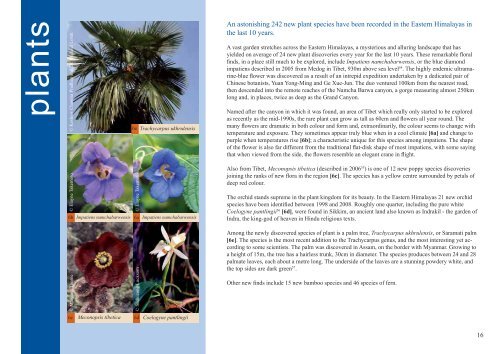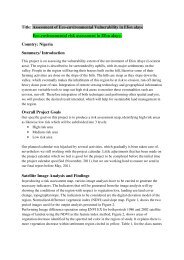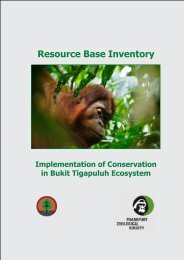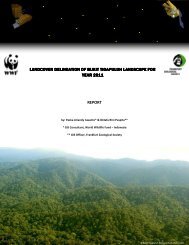The Eastern Himalayas New Species Discoveries
The Eastern Himalayas New Species Discoveries
The Eastern Himalayas New Species Discoveries
Create successful ePaper yourself
Turn your PDF publications into a flip-book with our unique Google optimized e-Paper software.
plants<br />
© Keshow Chandra Pradhan and Dr. Michael Lorek<br />
6e<br />
Trachycarpus ukhrulensis<br />
An astonishing 242 new plant species have been recorded in the <strong>Eastern</strong> <strong>Himalayas</strong> in<br />
the last 10 years.<br />
A vast garden stretches across the <strong>Eastern</strong> <strong>Himalayas</strong>, a mysterious and alluring landscape that has<br />
yielded on average of 24 new plant discoveries every year for the last 10 years. <strong>The</strong>se remarkable floral<br />
finds, in a place still much to be explored, include Impatiens namchabarwensis, or the blue diamond<br />
impatiens described in 2005 from Medog in Tibet, 930m above sea level 54 . <strong>The</strong> highly endemic ultramarine-blue<br />
flower was discovered as a result of an intrepid expedition undertaken by a dedicated pair of<br />
Chinese botanists, Yuan Yong-Ming and Ge Xue-Jun. <strong>The</strong> duo ventured 100km from the nearest road,<br />
then descended into the remote reaches of the Namcha Barwa canyon, a gorge measuring almost 250km<br />
long and, in places, twice as deep as the Grand Canyon.<br />
Named after the canyon in which it was found, an area of Tibet which really only started to be explored<br />
as recently as the mid-1990s, the rare plant can grow as tall as 60cm and flowers all year round. <strong>The</strong><br />
many flowers are dramatic in both colour and form and, extraordinarily, the colour seems to change with<br />
temperature and exposure. <strong>The</strong>y sometimes appear truly blue when in a cool climate [6a] and change to<br />
purple when temperatures rise [6b]; a characteristic unique for this species among impatiens. <strong>The</strong> shape<br />
of the flower is also far different from the traditional flat-disk shape of most impatiens, with some saying<br />
that when viewed from the side, the flowers resemble an elegant crane in flight.<br />
© Elayne Takemoto<br />
© Elayne Takemoto<br />
6b Impatiens namchabarwensis 6a Impatiens namchabarwensis<br />
Also from Tibet, Meconopsis tibetica (described in 2006 55 ) is one of 12 new poppy species discoveries<br />
joining the ranks of new flora in the region [6c]. <strong>The</strong> species has a yellow centre surrounded by petals of<br />
deep red colour.<br />
<strong>The</strong> orchid stands supreme in the plant kingdom for its beauty. In the <strong>Eastern</strong> <strong>Himalayas</strong> 21 new orchid<br />
species have been identified between 1998 and 2008. Roughly one quarter, including the pure white<br />
Coelogyne pantlingii 56 [6d], were found in Sikkim, an ancient land also known as Indrakil - the garden of<br />
Indra, the king-god of heaven in Hindu religious texts.<br />
© Margaret Thorne<br />
© Sudhizong Lucksom<br />
Among the newly discovered species of plant is a palm tree, Trachycarpus ukhrulensis, or Saramati palm<br />
[6e]. <strong>The</strong> species is the most recent addition to the Trachycarpus genus, and the most interesting yet according<br />
to some scientists. <strong>The</strong> palm was discovered in Assam, on the border with Myanmar. Growing to<br />
a height of 15m, the tree has a hairless trunk, 30cm in diameter. <strong>The</strong> species produces between 24 and 28<br />
palmate leaves, each about a metre long. <strong>The</strong> underside of the leaves are a stunning powdery white, and<br />
the top sides are dark green 57 .<br />
Other new finds include 15 new bamboo species and 46 species of fern.<br />
6c<br />
Meconopsis tibetica<br />
6d<br />
Coelogyne pantlingii<br />
16

















